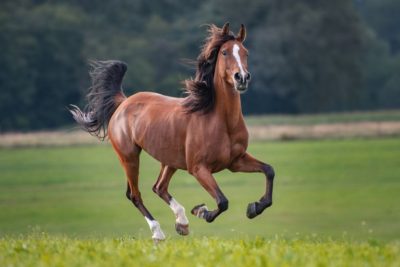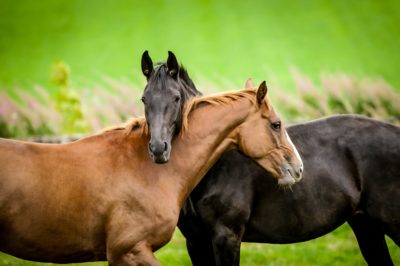
Searcy, AR (LP) — Horses are special creatures. They are majestic, strong and can display a broad range of emotions. Whether they’re around humans or other horses, they are amazingly communicative and thrive in social settings. These qualities are part of the reason why horses can develop such a strong bond with humans. Horses are not color blind, they have two-color, or dichromatic vision. In other words, horses naturally see the blue and green colors of the spectrum and the color variations based upon them, but cannot distinguish red. We’ve all seen our horses make strange expressions by curling their lips and showing us their teeth with a wide grin, but it’s not because they’re enjoying a good joke it’s actually part of a special nose-enhancing technique called the flehmen response. An adult male horse has 40 permanent teeth. A mare may have between 36-40, because mares are less likely to have canine (bridle) teeth.
Horses don’t form attachment bonds with their owners despite what equine enthusiasts might think but they do regard humans as ‘safe havens’ Horses think of humans as ‘safe havens’ but don’t form attachment bonds with their owners despite what equine enthusiasts might think, a new study reveals. A student at the Searcy high school Blair says, “Horses are not color blind, they have two-color, or dichromatic vision.” In 2012, animal behaviorists published a study that found horses are capable of recognizing and distinguishing humans through auditory and visual cues. A student at the Searcy high school Chloe says, “horses naturally see the blue and green colors of the spectrum and the color variations based upon them, but cannot distinguish red.” Their findings show that the horses often looked toward the familiar person when they heard that person’s voice. Blair says, “Due to domestication, they are found all over the world.” Horses don’t cry as an emotional response, but they shed tears when their tear ducts are blocked. Chloe says, “They also have long tails, short hair, muscular torsos, long thick necks and elongated heads.” However, horses express emotions with their actions; for example, they open their ears when mad, and yes, horses miss you when you are away from them. Blair says, “They have backbones which makes them vertebrates.” Many people believe horses cry because they shed tears. Fear not–there’s guidance in science. Chloe says, “Horses also have coats composed of hair that comes in a variety of beautiful colors and unique patterns.” Researchers have found that horses react more to yellow, white, black, and blue floors, as compared to floors that are green, red, brown, or gray. Horses don’t seem to mind these “less favorite” colors on walls rather than floors. Blair says, “All horse breeds, from slim thoroughbred racehorses to stocky plow horses to tiny ponies, belong to a single species, Equus caballus.” While horses possess strong emotional intelligence and an intuition that’s hard to beat, dogs learn new skills quickly and adapt well to life with humans. Chloe says, “The horse family (Equidae) today is quite small.” Whether you’re a team horse or team dog, there’s one thing we can all agree on: both horses and dogs are smarter than we think. Horses hate jazz and apparently they’re not that keen on rock music either. Clare concluded that they find jazz particularly disconcerting, with rock also increasing stress levels. Classical and country music, however, had a calming effect. Horses may not love each other in the same capacity of a human loving another human. But a horse can certainly feel and give affection.
Typically, a horse bites someone as a sign of aggression. Blair says, “Horse sizes range from towering, 6-foot draft horses to miniature ponies that barely top 2 feet.” However, in some cases, a horse can bite you in a playful manner or even as a sign of affection. Chloe says, “The average height of a horse is 15.2 hands, or around 5 feet.” Although this can seem sweet at first, any type of biting should be immediately discouraged. Blair says, “According to Scientific American, the first horses originated in North America and then spread to Asia and Europe.” Snails have the most teeth of any animal. Chloe says, “Horses have lived on Earth for more than 50 million years, according to the American Museum of Natural History. “ A garden snail has about 14,000 teeth while other species can have over 20,000. Blair says, “Zebras are classified in the genus Equus (known as equines) along with horses and asses.” Horses primarily lick people because they like the salt they get from the surface of our skin. But some horses also lick people out of habit, to explore, to play, or because they are bored. Chloe says, “These three groups are the only living members of the family Equidae.” When a horse licks its owner, most don’t give the reason for the lick a second thought. It’s generally better not to let your horse rub its head on you. The rubbing isn’t really a sign of affection. Other people are less likely to understand and accept a horse rubbing against them, and if your horse does this to someone, that someone may hit her, either out of fright or to “teach her manners”. A horses’ kick is powerful; it can break bones and most certainly kill you. Some people believe their horse is a chronic kicker and accept its bad behavior. But there is an underlying cause, and if nothing is done to discipline the animal, the problem will worsen, and someone is likely to get hurt. A new study shows, for the very first time, that horses respond to human emotional cues by integrating the emotional value of the voice they hear with that of the facial expressions they see. Share on Pinterest Horses can tell when human facial expressions and tone of voice match, according to a new study. Horses can read human facial expressions and remember a person’s mood, a study has shown. The animals respond more positively to people they have previously seen smiling and are wary of those they recall frowning, scientists found.

Since there are no nerve endings in the outer section of the hoof, a horse doesn’t feel any pain when horseshoes are nailed on. The prime-age in the horse lifespan is between 5 to 15 years. Most horses are in their prime by the time they turn 5 years old. That’s around the same time they start their official racing careers. Most jump racehorses are at the peak of their physical and mental ability between the ages of seven and ten. Instead of having a hard outer layer called enamel on their teeth, horses’ teeth are covered in a material called cementum that is actually softer and more porous than enamel. Cementum is easily stained, which is why horses usually have yellow or brown teeth.
